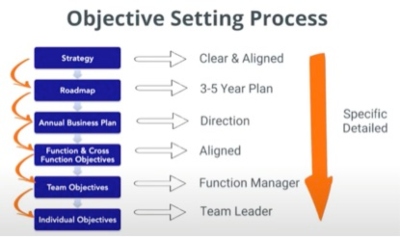Writing Employee Objectives
Establishing employee objectives is the first step of your Performance Management Process. Performance management is annual cycle where strategic and operational goals are cascaded to individual objectives. People managers then provide guidance and support to employees to deliver on their objectives.
Objective setting involves planning and organising your work to deliver on the strategy and annual business plan. The Process usually kicks off in January. People managers evaluate performance of their individual team members for the previous year and set objectives for the New Year. My Training Video and free Performance Management Guidebook step you through this process. Read on below video.
There are many benefits to having a formal objective setting process.
- Proves clarity at all levels of the organisation the priorities and expected results.
- Allows you maximise the use of your resources.
- Helps you to harness the potential, the skill and the competency of the organisation.
- Empowers employees to take responsibility, enhancing motivation and engagement.
- Sets up your performance management process.
People often get confused between job descriptions and objectives. A job description relates to a role on the organisation chart, this role captures the accountabilities and competencies that are important to delivering the strategy and business plans over the long term. A job description and is not person dependent. Objectives are the annual specific employee deliverables.

Objective Setting Process
Objectives are cascaded from strategy getting more specific as they are cascaded
- The strategy needs to be clear and aligned across the organisation.
- Function heads actively participate in the development of the company strategy to ensure that functional requirements are represented at a strategic level.
Strategy is cascaded to a 3-5 year roadmap, the roadmap is then cascaded to an annual business plan. This plan gives direction to the organisation for annual objective setting.
Function heads align on cross-function objectives (as you can’t assume support or prioritisation).
The function management cascade the function objectives to team objectives then the team leader cascades these to individual objectives.
As objectives are cascaded they get more specific and detailed. This is necessary to make sure that employees know exactly what they are expected to deliver.
Team leaders role
When the objectives have been cascaded, the team leader discusses and aligns on the individual objectives with each employee, this helps to firm up the objectives and to drive ownership and engagement
- At the discussion expected results, priorities, challenges, resources and requirements from others are discussed.
For cross-functional objectives, the function manager or relevant team leader aligns on deliverables, responsibilities, priorities and timelines with those you depend on to deliver the results.
Objectives are captured using a standard performance management template, this ensures consistent objective setting across the organisation.
Additional information to support objectives setting is included in my Performance Management Guidebook
- Performance Management Template
- SMART Criteria
- Example Categories
- Example Action Verbs
- Example Objectives
- Example Personal Development Objectives. These are strongly focused on soft skills and can be difficult to write.
On completion of the objective setting process, communicate a summary of the organisation, function and team objectives across your teams. This will provide employees with sight of how their role and objectives contribute to the company strategy and priorities.
There are always unforeseen objectives, have an objectives process that is flexible and allows re-prioritisation as needed. Communicate to the organisation when direction and priorities have changed
The above Training Video and my free Performance Management Guidebook will provide you with the information you need to write objectives.






